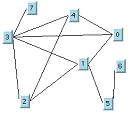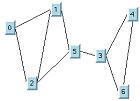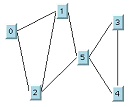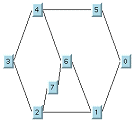C
child node
A node connected to the current node that is farther way from the root node. In a tree, all links incident to a parent node end at child nodes, except one, which ends at the parent node's parent node.
cluster
A set of nodes that must be placed close together. Circular layout places clusters as rings or stars. See also
ring and
star.
colinear
(Hypergraph) Segments in a
hyperedge that have the same angle. Colinear segments should not be connected.
connected component
A connected graph or subgraph. A connected component of a flat graph G is a maximal connected subgraph of G.
connected graph
A graph where there is a path connecting each pair of nodes. See also
disconnected graph.
connection
Another name for an edge of a graph. See also
edge.
constraint
A specification that limits the area where objects can be placed. For example, there can be a constraint that one object must be placed to the left of another object.
cut-edge
An edge is a cut-edge if the graph is no longer connected when the edge is removed from the graph. In the following graph, the link between nodes 3 and 5 is a cut-edge. Note that its end points are cut-nodes.
cut-node
A node is a cut-node if the graph is no longer connected when the node is removed from the graph. In the following graph, node 5 is a cut-node.
cycle
A path of a graph that begins and ends on the same node. Also called a loop.
cyclic graph
A graph that contains cycles.
cyclomatic number
A number equal to m - n + 1, where m = number of edges and n = number of nodes. In the following illustration, the number of edges = 10, the number of nodes = 8. Therefore, the cyclomatic number is 10 - 8 + 1 = 3.
Copyright © 2018, Rogue Wave Software, Inc. All Rights Reserved.



